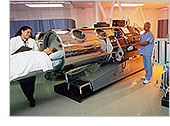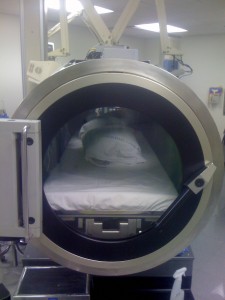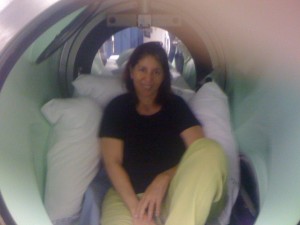Many of you are aware that I beat tongue cancer with heavy radiation and chemo back in 1996. The radiation burned out my salivary glands and the lack thereof over these years has led to dental decay with which even the dentist cannot keep up. The upshot is that I have had more root-canals than I can count and 6 more teeth were pulled in August (2 had been pulled in 2008).
 The extractions weren’t so bad (done in hospital, under anesthesia) but my ability to heal from oral surgery is compromised due to the radiation I absorbed during the cancer war — it killed more than just the salivary glands — the diagnosis is osteoradionecrosis (dead bones). Hyperbaric Oxygen Treatment (HBOT) is the prescription, 2-hours a day, five days a week, starting two weeks before surgery and continuing after for as long as it takes for the ‘wounds’ close up. This little image is not me, but it is the actual chamber you’ll find me in from 7-9 AM, M-F for awhile.
The extractions weren’t so bad (done in hospital, under anesthesia) but my ability to heal from oral surgery is compromised due to the radiation I absorbed during the cancer war — it killed more than just the salivary glands — the diagnosis is osteoradionecrosis (dead bones). Hyperbaric Oxygen Treatment (HBOT) is the prescription, 2-hours a day, five days a week, starting two weeks before surgery and continuing after for as long as it takes for the ‘wounds’ close up. This little image is not me, but it is the actual chamber you’ll find me in from 7-9 AM, M-F for awhile.
You can’t take anything into the chamber with you, no books, nada. There’s no room to move around, but you can listen to music or watch a dvd through a porthole. My preference is to lie down and listen to music. But sometimes I am not given the lie-down option and have to sit in the back compartment (pictured). In chamber I seem to fare best listening to instrumentals rather than vocals, and orchestral rather than small ensemble, though I did spend two days listening to solo piano from the Live at Maybeck Hall series. Recent listening includes Jim Hall’s Textures and By Arrangement, Bob Brookmeyer’s Get Well Soon, and Quincy Jones’ Big Band Complete 1960 European Concerts.
Hyperbaric oxygen therapy works by “force-feeding” pure oxygen to the bloodstream, tissues and cells. Treatments make me feel like DiverDevra (do you remember Diver Dan on TV?) – you are placed in a submarine-like compartment which is then pressurized. The earth’s atmosphere normally exerts approximately 15 pounds per square inch of pressure at sea level. That pressure is defined as one atmosphere absolute (abbreviated as 1 ATA). The chamber gets pressurized to 2 ATA, and by elevating the atmospheric pressure and increasing oxygen intake, oxygen is transferred through the membrane of the red blood cells at a much greater, more effective rate to saturate the bloodstream, tissue and cells.


The hoped-for end result is that the gum tissue will grow to fill in the gaps and cover all exposed bone. But until the bone is buried, you’ll find me popping antibiotics and diving.
